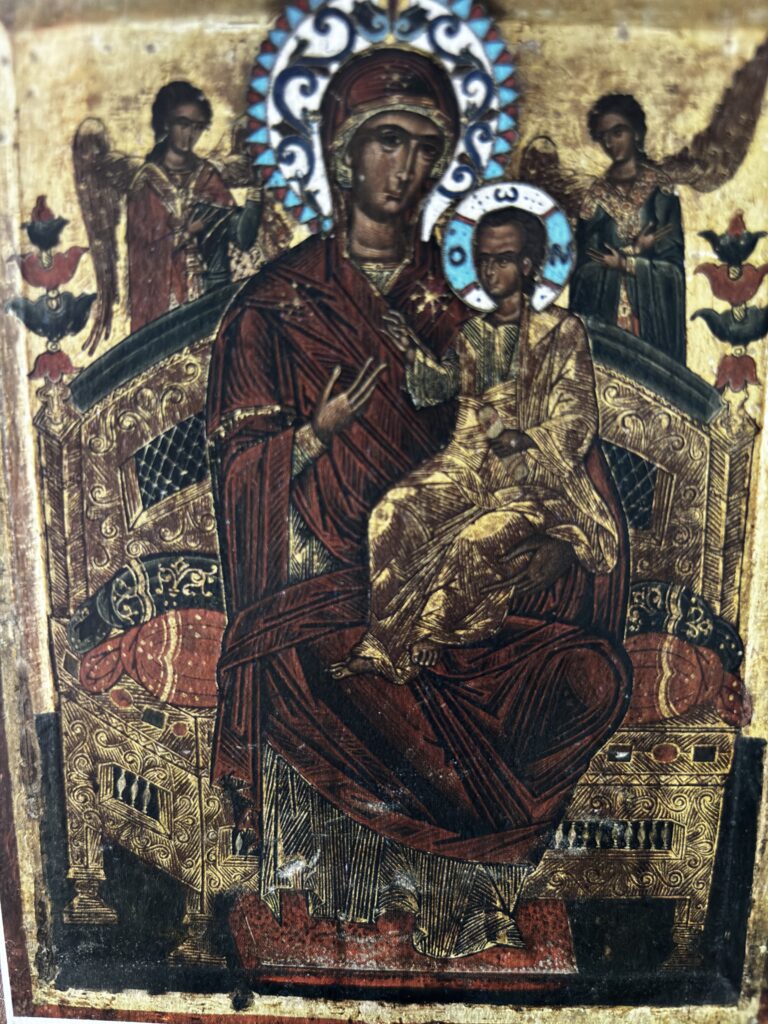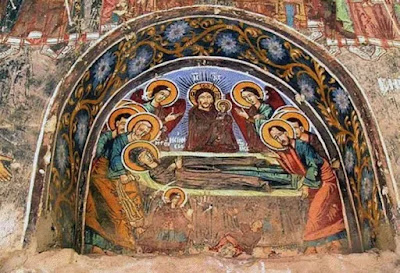
Panagia Pantanassa – Monastério Vatopedi – sec XVII

“O ícone milagroso, datado do século XVII, é colocado no lado esquerdo do pilar oriental do Catholicon (Doma).
De acordo com os relatos dos antigos monges do monastério, a primeira indicação de que o ícone tem uma graça particular foi o seguinte incidente: um dia, um jovem entrou na igreja e, no porão onde ele foi para adorar o ícone, o rosto da Virgem foi iluminado de repente, e uma força invisível o jogou no chão.
Quando ele caiu em si, ele confessou chorando aos velhos monges e disse que estava vivendo longe de Deus e lidando com magia negra.
A intervenção milagrosa da Virgem encorajou o jovem a mudar sua vida e se tornar um homem piedoso e se batizou.
Este ícone também tem a qualidade e graça especial da parte de Deus para curar a terrível doença do câncer.
Incontáveis pacientes oncológicos são hoje curados após uma oração ao ícone de Nossa Senhora Panagia Pantanassa (A Raínha de Todos).”
Fonte: Le Saint et Très-Grand Monastere de Votapaidion – Guide do Visiteur – Mont Athos, página 66.
São José, o Hesicasta, citado no filme Panagia Pantanassa, proclamou a importância de Panagia Pantanassa como a rainha de todos:
“Você deve ter medo de Deus como um constante adorno, humildade como um modesto tempero, e a Rainha de Todos (Pantanassa), como sua Protetora poderosa.”
Um ícone do tipo Panagia Pantanassa teria sido pintado pelo apóstolo Lucas no local onde seria construída a Basílica de Saidnaya na Siria, fundada pelo imperador bizantino Justiniano em 547, e o poeta Giraud, mencionado no Filme Panagia Pantanassa, fez a seguinte declaração sobre ele em 1175:
“Nesta igreja, vi uma imagem pintada em madeira… numa janela do santuário e fortemente guardado por uma grade de ferro. É a imagem da Santíssima Virgem.
Mas agora, é maravilhoso dizer, a pintura está encarnada na madeira, e um óleo mais perfumado que um bálsamo jorra dela sem cessar.
Uma multidão de cristãos, sarracenos e judeus foram curados de várias doenças por este óleo.
E observo que esse óleo nunca diminui, não importa quanto seja ingerido.
Ninguém se atreve a tocar nesta pintura, mas todos podem vê-la.
O azeite é conservado religiosamente, e quando o tomamos com devoção e fé, em honra da Santíssima Virgem e com a devida reverência, obtém-se infalivelmente tudo o que se pede.
(Giraud, 1175)
Archimandrita Makarios da Austrália disse que “Se pudéssemos ver com os olhos da nossa alma, testemunharíamos a nossa Panagia, ajoelhada diante do trono de Deus, orando pelo mundo inteiro”.
O impostor não se arrependeu e morreu rapidamente em decorrência de sua impiedade.
As Réplicas do ícone Panagia Pantanassa são Milagrosos
Este ícone da Panagia Pantanassa é do século XVII.
O ícone recebeu uma graça especial para curar a terrível doença do câncer em nossos dias.
Era um ícone pessoal do frei José de Vatopedi, que nos anos 90 se mudou para o Mosteiro de Vatopedi.
O primeiro milagre como sinal de que este não é um simples ícone aconteceu quando um jovem se aproximou do ícone com o objetivo de despertar para a luz.
De repente, uma luz brilhou do rosto do ícone e uma força invisível o empurrou para longe.
Quando ele voltou a si, começou a se arrepender, a confessar com lágrimas nos olhos aos padres do mosteiro que havia vivido longe de Deus e que estava envolvido em magia.
Assim foi como a Santíssima Theotokos radicalmente mudou sua vida espiritual.
Também vale ressaltar mais um milagre que aconteceu em 1991.
Um sacerdote russo veio ao Mosteiro de Vatopedi.
Aqui ele comprou muitas cópias em papel da milagrosa imagem Pantanassa.
Quando ele retornou à Rússia, distribuiu-as no Centro Infantil de Câncer em Moscou.
Havia uma criança de um ano, Mikhail Yakunin, que sofria de câncer.
Em frente à sua cama estava pendurada uma das cópias em papel da imagem da Pantanassa que o sacerdote trouxe.
E então um dia o coração do menino parou. Naquele momento sua mãe e enfermeira estavam por perto.
De repente eles viram raios de luz descerem daquela imagem em papel sobre o menino.
O menino imediatamente voltou à vida.
Este foi um grande milagre, que posteriormente contribuiu para que, a pedido do Patriarca de Moscou, uma cópia da imagem Pantanassa fosse enviada para a igreja localizada ao lado do hospital.
Mais tarde essas imagens fizeram milagres na Romênia, Moldávia e Ucrânia.
Fonte: Icons of Panagia – Episode 6: Panagia Pantanassa do Canal do Youtube Greek Orthodox Christian Society Sydney
Além dos frescos e mosaicos, o Monastério Vatopedi possui as santíssimas relíquias de diversos santos, como a orelha incorruptível de São João Crisóstomo (a que ouviu o Apóstolo Paulo).
Conta-se que quando o Santo São Chrisóstomo interpretava as cartas do Apóstolo Paulo, o discípulo do Santo, São Proclo, viu o Apóstolo Paulo ditando em seu ouvido esquerdo. Prova deste fato espantoso é a orelha esquerda incorrupta do Santo que foi conservada pela Graça Divina.
Entre os cerca de quarenta santos surgidos no mosteiro estavam o grande teólogo da Igreja Ortodoxa, São Gregório Palamas (séc. XIV), e o iluminador do povo russo, São Máximo, o Grego (séc. XVI).
Panagia Pantanassa at Saidnaya Basilic in Syria
‘In this church, I saw an image painted on wood … in a window of the sanctuary and strongly guarded by an iron grill. It image of the Blessed Virgin.
But now, wonderful to tell, the painting is incarnate upon the wood, and oil more fragrant than balm streams from it without cease.
A multitude of Christians, Saracens, and Jews have been cured of various illnesses by this oil.
And note that this oil never diminishes, no matter how much is taken.
No one dares to touch this painting, but all can see it. The oil is religiously conserved, and when one takes it with devotion and faith, in honour of the Holy Virgin and with due reverence, one obtains unfailingly whatever one asks for.
(Giraud, 1175)
If we could see with the eyes of our soul, we would witness our Panagia, kneeling at the throne of God, praying for the entire world.
Archbishop Makarios of Australia

By Metropolitan Hierotheos of Nafpaktos and Agiou Vlasiou
The troparia composed by the hymn writers of the Church for the Christians to celebrate the feasts, as well the feast of the Dormition of the Panagia today, are masterpieces, from the structure, the images and the cosmetic adjectives they use, as well as from their content, which answer the great existential problems of mankind, such as matters of life and death. When one reads these troparia carefully one is amazed by their wisdom and beauty.
The Canon we chanted today in the Service of Matins is included in this category and is the work of Saint Kosmas the Poet, who was the step-brother of Saint John of Damascus.
This Canon has amazing troparia that analyze the content of the feast and show its importance.
The acrostic of these troparia, that is, the initial letter of all the troparia, has the following phrase: “the godly-minded kept festival” (πανηγυριζέτωσαν οι θεόφρονες).
I would like to make a small comment on this phrase.
First we have to look at the word “festival”. The word festival in ecclesiastical language means a group celebration with the feasts referring to Christ, the Panagia and the Saints celebrated by each location.
The ecclesiastical festival includes prayer, participation in the Divine Liturgy, and communion of the Body and Blood of Christ, after relevant preparation, ie repentance, confession, etc.
Of course, people have associated the festival with entertainment and dancing. The Church does not exclude external joy, when the ecclesiastical feast precedes and when it takes place with the relevant conditions and in the appropriate ways.
But when the entertainment is at the expense of worship and especially of the Divine Liturgy, and contrary to the tradition of the Church, then it does not benefit spiritually.
If we study the way people used to keep festival, then we will see the difference with some modern ways of keeping festival.
However, the real festival is the Divine Liturgy and in general the worship of the Church. Man in the Divine Liturgy sings with the angels, prays with the Saints, communicates with the Panagia, is connected with Christ.
As the Fathers of our Church say, the Divine Liturgy is a unity of angels and men, reposed and alive. Whoever truly senses the Divine Liturgy as a festival, sees the change in their life as well, and can behave in a better way to their fellow human beings.
The next word of the acrostic is “the godly-minded”, that is, those should celebrate who think according to God.
The Apostle Paul writes to the Colossians: “Set your mind on things above, not on things on the earth” (Colossians 3:2).
Ecclesiastical festivals are celebrated by those people who have the mind of God, who aim at experiencing the meaning of the festival.
The Prophets in the Old Testament and the Holy Fathers in the Church fought for people to learn to celebrate according to God and not in a secular way.
This also applies to today’s feast of the Dormition of our Panagia.
The meaning of this feast is spiritual, since the Panagia experienced the resurrection of Christ in her existence and now she is in heaven and stands on our behalf.
The Panagia synergized in the mystery of our salvation and that is why we must give her the due reverence. We must always keep festival as those who are godly-minded, that is, with fasting and repentance preceding communion of the Body and Blood of Christ, living an ecclesiastical way of life and striving to keep the will of her Son and her God in our lives.
I wish you all many years on today’s great feast of the Mother of God.
Source: Translated by John Sanidopoulos.
Produzido por

Consulte a Agenda do Museu a partir de 2025 e o visite quando receber sua confirmação de visita em seu email ou whatsapp.
Por se tratar de um museu particular, é necessário se cadastrar na Comunidade MuMi e customizar sua visita.
Criação e Tecnologia: Clayton Tenório @2025 MuMi – Museu Mítico